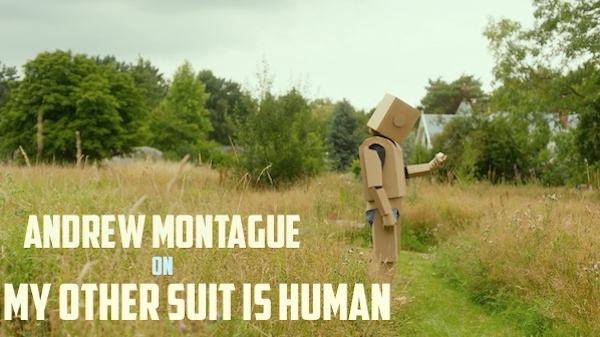Coping With The Pieces: Andrew Montague On His Short "My Other Suit Is Human"
Director Andrew Paul Montague is an award-winning Irish writer. His latest film film, My Other Suit is Human, is currently on the festival circuit and was selected for the prestigious 32nd Galway Film Fleadh in the New Talent Irish Shorts section for its World Premiere. The film focuses on a couple who struggle after tragically losing their child.
Zoe, grieving for her deceased son, has become distant from her emotionally unavailable husband who buries himself in work. Dealing with her grief alone, she seeks refuge in the form of a homemade robot suit. Slowly, she works to rediscover herself and her marriage.
The film recently screened at the Oscar-qualifying HollyShorts Film Festival. We had the pleasure of chatting with Andrew about his film, discovering its look, the secret to creating a stunning robot suit out of cardboard, and much much more!
What excited you most about telling this particular story?
What excited me most was being able to examine the relationship between people and look at how a couple cope with the pieces left over after a tragedy has taken place. How people deal with grief and struggle to overcome was an interesting challenge for the film and for me as a writer.
One of the things I liked about the film is how it grapples with dark themes but is depicted with very bright, optimistic cinematography. Tell us a bit about how you worked with Zeta Spyraki to discover the film’s aesthetics.
The use of accentuated natural light to enhance the story and theme of the film was something that Zeta and I had talked about in pre-production. We wanted the inside of the house to feel colder in juxtaposition to the bright and warmth outside, so the house would have more of a sadness that surrounded them and the suit would be a way of blocking that out. When we were outside the house, we wanted to have the wide open spaces filmed with a wide lens to create the opposite from inside the house where we look everything feels tighter.
The film uses negative space in a clever way to externalize the internal struggle of the characters. Can you talk about your approach to framing?
Myself and Zeta had talked quite extensively about my plan to approach this as quite an observational piece with a lot of locked off camera shots to capture the actors move within the scene. Any movement of the camera was motivated by the action within the scene such as a character moving through to another room. We intentionally had the characters not share the same frame at the start in order to give a sense that they were not emotionally in the same place.
A prominent feature in the film is Zoe’s cardboard robot suit. That thing looked pretty chic and seamless for a DIY getup. What’s the secret to making a stellar homemade robot costume?
The secret is working with an amazing prosthetics artist, Chris Fitzpatrick who has over 20 years experience in the business. He did a full body cast of Beth and built the suit around the cast so it fitted perfectly. There was so much preparation in the design of the helmet and making sure it was both comfortable to wear but also practical to move and see through. The trick was to make it look like it was something that could be homemade too. It’s deceptively complicated with how it all comes together!
What’s your favorite scene or depiction of grief?
My favorite scene in the film is a tie between the last scene on the beach where we see them together and also the scene at the sink where Zoe’s suit breaks in the water and she realises how fragile she still is. I wanted to see her reaction in one shot so the emotion that comes out is so raw.
What drew you to the visual arts? How did you get into directing?
All my family have been involved in the arts and it was just a natural progression for me to follow. I grew up in a town with a film studios in it and I’ve always been fascinated by film. I studied as an actor and acted in plays and TV but I wanted to move behind the camera to work as a writer and director so I made the decision to go to film school to hone and develop my skills.
What films or filmmakers have inspired you, your style, or your approach to storytelling?
I’ve always been inspired by iconic directors such as Bergman, Hitchcock, and Altman but also fly approach to filmmaking has been influenced by modern directors like Noah Baumbach, Spike Jonze, and Michel Gondry, who are able to think of universal themes with a very iconic voice. I love creating in camera effects and working with actors to create emotionally resonating pieces of work.
What do you hope audiences take away from the film?
I hope that people take away the knowledge that grief affects everyone differently and that there’s no right or wrong way to grieve but that finding support is important to help move on.
Do you have any future projects in the works that you can share with us?
Myself and Kira Fitzpatrick, the producer of My Other Suit is Human, are working on developing our next short film, a film that deals with dementia with a fantasy element. We’re also developing our first feature that we’re hoping to shoot back home in Ireland with Kira’s production company, Abhaile Films.
What do you think? We want to know. Share your thoughts and feelings in the comments section below, and as always, remember to viddy well!




